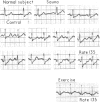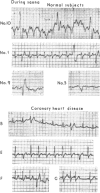Abstract
We have studied the effect of a short period of exposure to the intense heat of a sauna bath on the electrocardiogram and plasma catecholamine, free fatty acid, and triglyceride concentrations in 17 subjects with apparently normal hearts and 18 persons with coronary heart disease. Similar observations were made on 11 of the 17 normal subjects and on 7 of the persons with coronary heart disease in response to exercise.
Exposure to heat was associated with an increase in plasma adrenaline with no change in noradrenaline, free fatty acid, or triglyceride concentrations. Exercise was associated with the expected increase in both plasma noradrenaline and adrenaline concentrations. A heart rate up to 180 beats/min was observed in response to both heat and exercise. Apart from the ST-T changes inherent to sinus tachycardia, ST-T segment abnormalities were frequent in response to heat in both the subjects with normal and abnormal hearts, but little change occurred in the ST-T configuration when the subjects were exercised to produce comparable heart rates. Ectopic beats, sometimes numerous and multifocal, were observed in some subjects of both groups in response to heat, but not to exercise. It seems likely that the net unbalanced adrenaline component of the increased plasma catecholamine concentrations (which is also seen in certain emotional stress situations) is predominantly responsible for ischaemic-like manifestations of the electrocardiogram in susceptible subjects. The observations provide further validation for previously reported studies that it is the increased plasma noradrenaline in response to emotional stress that is associated with the release of free fatty acids and ultimate hypertriglyceridaemia, of probable importance in the aetiology of atheroma.
Full text
PDF





Images in this article
Selected References
These references are in PubMed. This may not be the complete list of references from this article.
- CARLSON L. A., OROE L. PERSISTENCE OF THE INHIBITORY EFFECT OF NICOTINIC ACID ON CATECHOLAMINE-STIMULATED LIPID MOBILIZATION DURING PROLONGED TREATMENT WITH NICOTINIC ACID. J Atheroscler Res. 1965 Jul-Aug;5(4):436–439. doi: 10.1016/s0368-1319(65)80080-1. [DOI] [PubMed] [Google Scholar]
- Carruthers M. E. Aggression and atheroma. Lancet. 1969 Nov 29;2(7631):1170–1171. doi: 10.1016/s0140-6736(69)92491-x. [DOI] [PubMed] [Google Scholar]
- Carruthers M., Conway N., Somerville W., Taggart P., Bates D. Validity of plasma-catecholamine estimations. Lancet. 1970 Jul 11;1(7663):62–67. doi: 10.1016/s0140-6736(70)92638-3. [DOI] [PubMed] [Google Scholar]
- Hanson J. S., Tabakin B. S., Levy A. M. Comparison of cardiorespiratory responses to graded upright exercise of normal men aged 20-29 and 30-39. Br Heart J. 1966 Jul;28(4):557–565. doi: 10.1136/hrt.28.4.557. [DOI] [PMC free article] [PubMed] [Google Scholar]
- Johnson R. H., Walton J. L., Krebs H. A., Williamson D. H. Post-exercise ketosis. Lancet. 1969 Dec 27;2(7635):1383–1385. doi: 10.1016/s0140-6736(69)90931-3. [DOI] [PubMed] [Google Scholar]
- Jurand J., Oliver M. F. Effects of acute myocardial infarction and of noradrenaline infusion on fatty acid composition of serum lipids. Atherosclerosis. 1970 Jan-Feb;11(1):157–170. doi: 10.1016/0021-9150(70)90013-4. [DOI] [PubMed] [Google Scholar]
- Kurien V. A., Yates P. A., Oliver M. F. The role of free fatty acids in the production of ventricular arrhythmias after acute coronary artery occlusion. Eur J Clin Invest. 1971 Jan;1(4):225–241. doi: 10.1111/eci.1971.1.4.225. [DOI] [PubMed] [Google Scholar]
- LACHMAN A. B., SEMLER H. J., GUSTAFSON R. H. POSTURAL ST-T WAVE CHANGES IN THE RADIOELECTROCARDIOGRAM SIMULATING MYOCARDIAL ISCHEMIA. Circulation. 1965 Apr;31:557–563. doi: 10.1161/01.cir.31.4.557. [DOI] [PubMed] [Google Scholar]
- LEPESCHKIN E., MARCHET H., SCHROEDER G., WAGNER R., de PAULA E SILVA, RAAB W. Effect of epinephrine and norepinephrine on the electrocardiogram of 100 normal subjects. Am J Cardiol. 1960 May;5:594–603. doi: 10.1016/0002-9149(60)90124-7. [DOI] [PubMed] [Google Scholar]
- MITCHELL J. H., SHAPIRO A. P. The relationship of adrenalin and T-wave changes in the anxiety state. Am Heart J. 1954 Sep;48(3):323–330. doi: 10.1016/0002-8703(54)90021-6. [DOI] [PubMed] [Google Scholar]
- Page L. B., Raker J. W., Berberich F. R. Pheochromocytoma with predominant epinephrine secretion. Am J Med. 1969 Oct;47(4):648–652. doi: 10.1016/0002-9343(69)90195-8. [DOI] [PubMed] [Google Scholar]
- Somerville W., Taggart P., Carruthers M. Addressing a medical meeting: effect on heart rate, electrocardiogram, plasma catecholamines, free fatty acids, and triglycerides. Br Heart J. 1971 Jul;33(4):608–608. [PMC free article] [PubMed] [Google Scholar]
- Taggart P., Carruthers M. Endogenous hyperlipidaemia induced by emotional stress of racing driving. Lancet. 1971 Feb 20;1(7695):363–366. doi: 10.1016/s0140-6736(71)92207-0. [DOI] [PubMed] [Google Scholar]
- Taggart P., Gibbons D., Somerville W. Some effects of motor-car driving on the normal and abnormal heart. Br Med J. 1969 Oct 18;4(5676):130–134. doi: 10.1136/bmj.4.5676.130. [DOI] [PMC free article] [PubMed] [Google Scholar]
- el-Sherif N., Shahwan L., Sorour A. H. The effect of acute thermal stress on general and pulmonary hemodynamics in the cardiac patient. Am Heart J. 1970 Mar;79(3):305–317. doi: 10.1016/0002-8703(70)90418-7. [DOI] [PubMed] [Google Scholar]








